A new electric power solution that packs a punch

Partner Content produced by KHL Content Studio
21 February 2025
At first glance, that shipping container on the work site is just another generator set. But while the exterior might look familiar, everything is not necessarily as it seems.
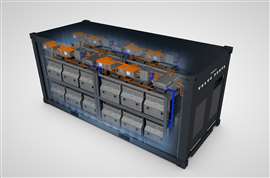 A BESS subsystem requires a robust battery management system to optimise performance and battery longevity
A BESS subsystem requires a robust battery management system to optimise performance and battery longevity
In the future, the contents of that steel box could be very different from today’s power delivery systems.
That’s because the container might be housing a battery-energy storage system, or BESS. While not yet in widespread use, that could be set to change due to the flexibility these units offer when operating a microgrid, or serving as backup power for an energy-critical business.
As the name suggests, a BESS is primarily comprised of battery packs. But not all battery packs are the same, as Darren Tasker, vice president of Industrial Sales at Volvo Penta North America explains.
“In some of the BESS subsystems that we supply, we use the latest third-generation packs sourced from Volvo; they’re the same packs which are used on the heavy-duty trucks. Instead of an LFP lithium-ion cell, we have nickel manganese cobalt (NMC) chemistry, which delivers a really good energy density.”
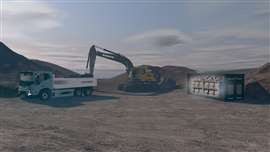 A high-performance BESS provides reliable, rapid power delivery in the most demanding environments
A high-performance BESS provides reliable, rapid power delivery in the most demanding environments
Cool running
Energy density refers to the capability to hold a lot of electrical energy in a comparatively small package.
This is critical for heavy trucks, as battery weight and size must be kept to a minimum to allow maximum cargo, while still delivering necessary power and vehicle range.
Tasker says, “The packs were originally designed to move a truck with a heavy payload, so that required very high energy density. So we’ve taken that technology and our packaging partners have reworked it for use in a BESS.
“Energy density can make a big difference when using a BESS,” he continues. “It can support energy-intensive applications, like a data centre, while it also results in a smaller footprint, which helps where there is limited space.”
 Darren Tasker, Vice President of Industrial Sales at Volvo Penta
Darren Tasker, Vice President of Industrial Sales at Volvo Penta
An energy-dense battery demands thermal controls to manage internal temperature. To maintain the optimum operating temperature, the NMC packs use a liquid cooling system.
This can maintain 30ºC regardless of the ambient air temperature, which creates a stable environment that supports maximum battery cell efficiency.
Management of the battery packs is controlled using software designed by Volvo Penta. But on top of that, another control platform, developed by Volvo Penta’s packaging partner UIG (Utility Innovation Group), delivers data to the operator covering battery charge and discharge rates, together with other performance details.
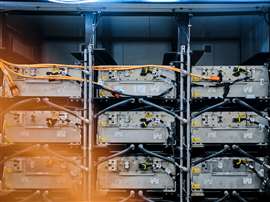 Key components in the BESS system include a DC/DC converter, a telematics gateway for real-time monitoring and a thermal management system to maintain optimal performance
Key components in the BESS system include a DC/DC converter, a telematics gateway for real-time monitoring and a thermal management system to maintain optimal performance
BESS benefits
Asked about the ideal application for a BESS, Tasker says that virtually any power delivery installation can benefit from the technology.
In one instance, a microgrid in Florence, Italy has 1.5 MW of BESS capacity linked to standard gen sets, as well as some limited solar and wind power generation.
In this setup the BESS can be used to store and deliver power collected from the renewable sources, while also storing excess energy from the gen sets – which, when operated on HVO or other biofuel, are effectively carbon neutral.
Should it be necessary to reduce site noise, the BESS can deliver power at periods when noise abatement protocols are in effect.
|
Component supplier Instead of building a finished BESS, Volvo Penta delivers the necessary hardware to an integrator for assembly of the final unit. “We take the battery packs, the control system, the cooling system, the heavy-duty cables and then add our R&D to deliver the components which make up the BESS,” explains Darren Tasker. “It’s the same as our gen sets, we supply the diesel engines and peripherals for packaging and final assembly.” The setup plays to the strengths of Volvo Penta, where the company can focus on development and delivery of hardware specifically for a BESS application and leave the integration, installation and servicing of the completed unit to the assembler. Volvo Penta provides warranties on each of the component parts used to assemble a BESS; according to Tasker, the warranty on the battery pack can be up to six years (dependent on usage, the charge/discharge frequency). |
Tasker says that additionally, incorporation of a BESS can allow downsizing of the gen sets, with those smaller models costing less upfront, taking up less space and offering better fuel efficiency.
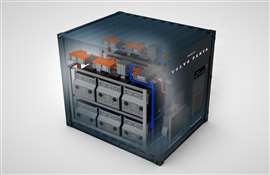 It’s possible for a large number of BESS systems to be deployed across a grid for greater redundancy and large overall capacity
It’s possible for a large number of BESS systems to be deployed across a grid for greater redundancy and large overall capacity
There’s also potential for the BESS to impact peak shaving – where increased energy spikes, or peaks, are used to calculate annual energy costs. Using a BESS to supplement other energy generation sources at high demand periods can reduce the size of those spikes and cut the amount – and cost – of energy taken from the grid.
Safety in operation
The latest BESS units also include systems that ensure safe operation.
“No BESS is shipped without our thermal management system,” states Tasker. “We believe it is a critical component in having the batteries perform safely today and into the future. And the best thermal management will extend the life of the battery packs.”
In addition to thermal management, every safety element of the battery packs developed to support on-highway use has been ported over and adapted for use with the BESS units. That includes the cooling and control systems, software logic and high-power cables supplied by Volvo Penta.
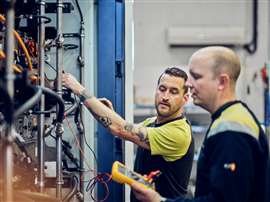 BESS systems are commonly designed to sustain their full rated power output for several hours
BESS systems are commonly designed to sustain their full rated power output for several hours
As a further safety measure, every connector, junction box and DC/DC converter has an HVIL – or high-voltage interlock loop. If any of these components are damaged or tampered with the BESS will shut down, which helps to prevent any further damage.
That said, the units are designed to be moved. Floor mounts have been designed to reduce and isolate vibration, while accidental impacts should not impair overall operation.
If there is an issue with the BESS, maintenance of the unit falls under the remit of Volvo Penta. Tasker adds that more dealers are being trained to support related work. Beyond that, direct technical support is also available.
“It’s the responsibility of anyone involved in this business to make sure that these units are as safe as they can be,” Tasker says.
|
Capacity and charging According to Darren Tasker, Volvo Penta now has a choice of two BESS units. The first houses 12 battery packs in a 10-foot container, while another option uses six battery packs arranged within a slightly smaller unit. The packs in the smaller system each have a 90 kWh capacity, meaning total storage is in excess of half a megawatt. The 1.5 C-rating (charge and discharge measurement) of the battery packs supports even higher energy storage. Using a standard outlet or energy collected from a small solar panel array will see the BESS recharging very slowly. Tasker says that a 480 V charge is best for rapid recharging. The units have recharging connectors for battery-electric machines from Volvo Penta, together with a standard charging point. An inverter within the BESS unit converts AC current from the grid to the DC current required by the batteries. To help cut costs, the invertor can be decoupled from the BESS. This allows a single invertor to recharge multiple interconnected BESSs, or it can recharge individual BESS units. |
--------
This article was produced by KHL Content Studio in collaboration with technology experts from Volvo Penta.
--------
All images courtesy Volvo Penta




